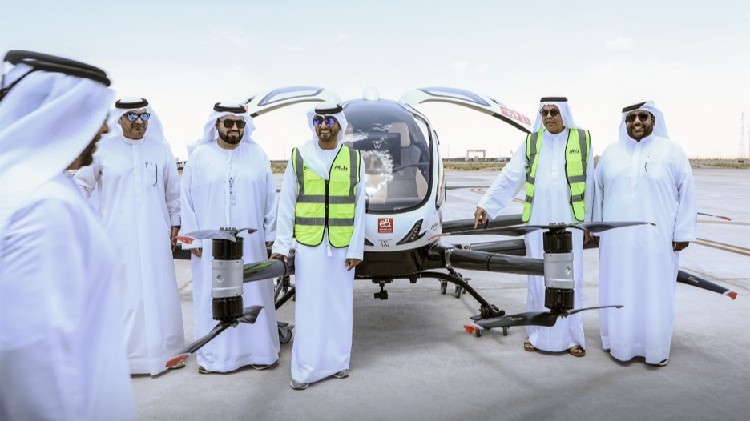Middle East Insights: Gulf nations adopt "low-altitude economy"
In recent times, Gulf nations have launched national development plans, including Saudi Arabia's "Vision 2030," the UAE's "We the UAE 2031," and Qatar's "National Vision 2030." These initiatives are designed to shift their economies away from reliance on energy resources, emphasizing technological advances, the creation of smart cities, and sustainable development.

Typically, the journey from Dubai International Airport to Palm Jumeirah spans 40 minutes by car. By 2026, this travel time is anticipated to shrink to just 10 minutes with the advent of air taxis, a transportation mode reminiscent of science fiction.
Passengers will soon be able to book this service online and travel at altitudes ranging from 500 to 1,000 meters.
What was once a futuristic vision in literature and film is becoming real in the Gulf countries. With these nations investing in their low-altitude economies, Chinese enterprises are taking the lead, actively contributing to local industrial growth.
Gulf nations embrace low-altitude economy
Recent years have seen Gulf countries roll out national development strategies including Saudi Arabia's "Vision 2030," the UAE's "We the UAE 2031," and Qatar's "National Vision 2030." These initiatives aim to shift their economies from a reliance on energy to a diversified model, emphasizing technological innovation, smart city developments, and sustainable growth.
Low-altitude aerospace technologies, such as electric vertical takeoff and landing (eVTOL) aircraft, are lauded for their intelligence, efficiency, and eco-friendliness, and fit well with the market demands of Gulf nations. Consequently, the low-altitude economy has emerged as a competitive and innovative arena in the region.
Dubai is at the forefront within the UAE's low-altitude sector and launched the "Dubai Horizon" project in 2022. This initiative, aimed at planning low-altitude flight routes and drone landing points, saw its first phase completed in 2023. The city plans to introduce air taxi services by 2026.
In April, Abu Dhabi received approval from the UAE's General Civil Aviation Authority to establish the nation's first micro-airport designed for electric vertical takeoff aircraft. Ras Al Khaimah is also collaborating with tech companies to initiate commercial air taxi operations by 2027, enhancing local tourism infrastructure with eVTOL services for inter-site travel.
Saudi Arabia is equally engaged, committing $100 billion in investments by 2030 to bolster both traditional aviation and low-altitude sectors including drones and eVTOL aircraft.
The country's ambitious NEOM project incorporates the air taxi concept, with an order placed for 15 eVTOL aircraft from a German company and $175 million earmarked for strategic collaboration in 2022. Saudi Arabia plans to deploy a fleet by 2025 and develop a variety of low-altitude flight modes in NEOM.
Qatar's Ministry of Transport also announced plans to test electric air taxis by early 2025 and has begun seeking test flight permits with domestic agencies.
The impetus for economic transformation, supportive national policies, market demand, and robust economic strength are all factors drawing low-altitude economy enterprises to the Gulf region.
He Tianxing, vice president of China's leading eVTOL manufacturer EHang, noted to CGTN that the Gulf boasts a high level of economic development, a favorable investment environment, and a strong foundation for adopting and nurturing high-tech innovations.
Leveraging strengths in cooperation
Chinese companies are focusing on the low-altitude manufacturing sector as they expand overseas.
Given the Gulf's vast lands, scattered urban and rural areas, extensive deserts, and harsh climate, the region is ideal for deploying low-altitude aircraft such as drones.
In particular, for oil and gas pipeline inspections, drones perform efficiently in the Gulf’s hot weather, operating safely and reliably in remote deserts. This allows manufacturing companies to offer tailored services. Equipped with navigation, positioning, and camera functions, these drones significantly boost inspection efficiency at relatively low operational costs.
Several Chinese technology companies, including EHang, Shanghai Fengfei, XPeng Huitian, and Yufeng Future, have already entered the Gulf market. Their products serve sectors such as air transportation, logistics, firefighting, emergency rescue, and pipeline inspections.
Leveraging domestic industrial chain strengths and innovative technologies, Chinese firms are exploring collaborative models suited to the regional market.
Overseas companies offer complete systems and technical support tailored to local client needs, while local firms manage low-altitude operations, including route applications, approvals, and pilot management.
According to an industry insider, this collaborative model not only creates job opportunities but also helps Chinese companies expand their local client base.
Multiple Chinese firms have secured partnerships with local entities in the UAE and other Gulf countries. In April, EHang inked a cooperation agreement with the Multi-Level Group and the Abu Dhabi Investment Office.
The company aims to establish a regional headquarters in Abu Dhabi and work with local partners on production, flight operations, R&D, training, maintenance, and overhauls, as mentioned by its vice president.
Various UAE and Saudi Arabian entities have signed procurement contracts for eVTOL aircraft with Chinese firms, and collaboration is expanding in areas such as aircraft battery charging and vertical takeoff and landing infrastructure.
Global investors are also keenly watching Chinese companies’ developments in low-altitude economy technology in the Gulf region. In March, China's Shidi Technology garnered $20 million in Series A funding from international investors to advance air taxi development in the Middle East.
In April, Shenzhen Urban Transportation Planning and Design Research Center Co., Ltd. informed investors that it would soon commence low-altitude economy operations in the Middle East, including the design of related solutions and platform development.
As China’s low-altitude economy continues to thrive, not just manufacturing exports but various sectors within the industry are making significant international strides.
Supervisor: Mu Li
Producer: Li Chao
Reporter: Wang Xuejing
Emily Johnson contributed to this report for TROIB News
Discover more Science and Technology news updates in TROIB Sci-Tech












